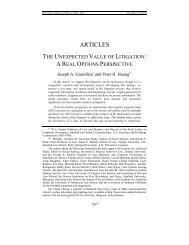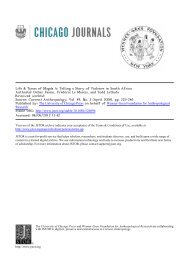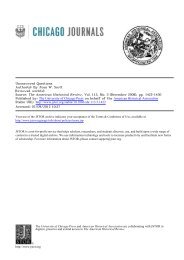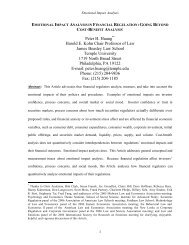Secure Implementation Experiments: Do Strategy-proof Mechanisms ...
Secure Implementation Experiments: Do Strategy-proof Mechanisms ...
Secure Implementation Experiments: Do Strategy-proof Mechanisms ...
You also want an ePaper? Increase the reach of your titles
YUMPU automatically turns print PDFs into web optimized ePapers that Google loves.
set of 25 integers, see Table 5. It is easy to check that 91% (=10/11) of payoffs in the region of<br />
bad Nash equilibria are not Pareto dominated by either of the dominant strategy equilibrium<br />
payoffs ((210, 196) or (210, 210)). The corresponding ratio in the region of good Nash equilibria<br />
is 92% (=150/163). Moreover, the ratio of Pareto efficient payoffs among bad Nash equilibrium<br />
payoffs is 45.5% (=5/11), while the corresponding ratio among good Nash equilibrium payoffs<br />
is 27.6% (=45/163).<br />
------------------------------------------<br />
Link to Tables 4 & 5<br />
------------------------------------------<br />
However, the pivotal mechanism was designed specifically to implement social<br />
decisions that satisfy the efficiency condition (4.1). This condition has played a central role in<br />
the literature. The experiments can shed light on whether or not the outcome will in fact be<br />
consistent with condition (4.1). If it is not, then the pivotal mechanism does not perform in the<br />
way described in the literature on efficient mechanism design, and a new theory may be<br />
needed.<br />
Treatment S is the same as Treatment P except for the payoff tables. The payoff tables<br />
for Treatment S are based on the following model of a Groves mechanism with single-peaked<br />
preferences with two players. Suppose that the true valuation functions of agent types 1 and 2<br />
are respectively v ( y) =−( y− 12)<br />
and v ( y) =−( y− 17)<br />
, where y ∈R + is the level of a public<br />
1<br />
2<br />
2<br />
good. Each type reports his most preferred level of the public good called a peak. Given a<br />
vector of reported peaks ( ~ r1, ~ r2 ) , the level of the public good, yr ( ~ , ~ r)<br />
, and the transfer to type i,<br />
ti( ~ r1, ~ r2 ) , are determined by a Groves mechanism: yr ( ~ 1, ~ r2 ) = (~ r1 + ~ r2)/<br />
2 and ti( ~ r , ~ r )<br />
− (( ~ r + ~ r )/ 2 −~ rj ) , i, j = 12 , ; j ≠ i . The payoff functions are therefore given by<br />
1 2<br />
2<br />
2<br />
1 2<br />
v ( y( ~ r , ~ r )) + t ( ~ r , ~ r ) = − (( ~ r + ~ r )/ 2 −12) − (( ~ r + ~ r )/ 2 −~ r ) ,<br />
1 1 2 1 1 2<br />
1 2<br />
2<br />
1 2 2 2<br />
v ( y( ~ r , ~ r )) + t ( ~ r , ~ r ) = − (( ~ r + ~ r )/ 2 −17) − (( ~ r + ~ r )/ 2 −~ r ) .<br />
2 1 2 2 1 2<br />
1 2<br />
2<br />
1 2 1 2<br />
1 2 =<br />
20
















